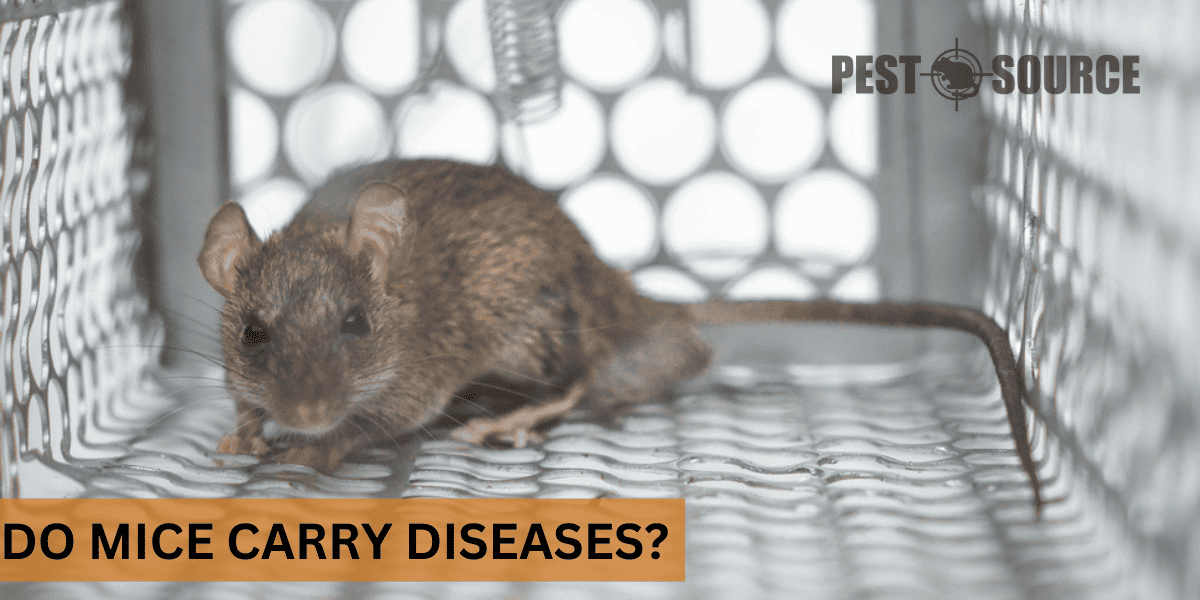Mice are known carriers of various diseases, which can be transmitted to humans. Learn about the specific diseases associated with mice and the importance of effective pest control and hygiene practices in minimizing health risks in areas with mouse populations.
POINTS
- Mice, both wild and domestic, are carriers of numerous diseases that can potentially harm human health. These include Hantavirus Pulmonary Syndrome (HPS), Salmonellosis, Lymphocytic Chorio-meningitis (LCM), and Leptospirosis among others.
- Humans contract diseases from mice through several routes, including inhalation of dust contaminated with droppings or urine from mice, ingestion of contaminated food or water, bites from an infected mouse, and via ticks or fleas that have fed on an infected mouse.
- Mice can indirectly affect human health by exacerbating allergies and asthma as their droppings, urine, and dander can contaminate indoor air.
- Correctly dealing with evidence of mouse activity, such as droppings and nests, is key to prevent disease transmission from mice. This involves careful cleanup using a bleach solution, protective gloves, and proper disposal procedures.
- The specific diseases each species of mice carries can vary, meaning that our geographical location, which dictates the types of mice we’re likely to encounter, can influence the risks associated with diseases spread by mice.
The Public Health Implications of Mice
How prevalent are mice in rural and urban areas?
In both rural and urban environments, mice are an incredibly prevalent mammal. They are especially fond of human-inhabited areas for the abundant access to food and protected nesting sites. House mice, known scientifically as Mus musculus, are found worldwide. In the USA, field mouse can refer to any of several species in the Peromyscus genus, depending on the region.
How do humans typically contract diseases from mice?
Humans typically contract diseases from mice through several routes:
- Inhalation: Breathing dust contaminated with droppings or urine from mice.
- Ingestion: Consuming food or water that has been contaminated by mouse’s fecal matter or urine.
- Mouse Bites: Being bitten by an infected mouse can lead to transmission of certain diseases.
- Parasites: Through ticks, fleas, or mites that have fed on an infected mouse and then bite a human.
Why is it essential to know about diseases carried by mice?
Understanding the diseases carried by common pest species like mice is vital for public health reasons. This knowledge ensures residential and commercial building occupants know the risks involved and can take appropriate preventative measures.
Comprehensive Overview of Diseases Carried by Mice
Mice can carry a number of serious diseases which, when transmitted to humans, pose significant health risks. Below, we will provide a comprehensive look at several of these diseases.
Hantavirus
Hantavirus is a collective term for several viruses within the Hantaviridae family, predominantly carried by certain species of rats and mice. In North America, deer mice, white-footed mice, rice rats, and cotton rats are known carriers. In humans, these viruses can lead to severe diseases – Hantavirus Pulmonary Syndrome (HPS) and Hemorrhagic Fever with Renal Syndrome (HFRS) among them.
Hantavirus Pulmonary Syndrome (HPS)
This severe respiratory disease is spread through the droppings, urine, and saliva of infected mice. Humans commonly contract this disease by breathing in air contaminated with the virus. Because of this, it is important to take precautions when cleaning up an enclosed space such as a shed, cabin or trailer where mice have nested or rodent droppings are present.
However, it can also spread through a bite, direct contact with infected mice or their droppings, or by consuming food or water contaminated with infected rodent urine, droppings, or saliva. There’s no specific treatment, cure, or vaccine for HPS. But early detection coupled with medical treatment in an intensive care unit can enhance survival rates.
Hemorrhagic Fever with Renal Syndrome (HFRS)
Hemorrhagic Fever with Renal Syndrome (HFRS) is a globally distributed disease caused by distinct hantaviruses. While it doesn’t occur in North or South America, it’s prevalent in other parts of the world including Europe and Asia. For instance, the Hantaan virus, a common cause of HFRS, is frequently encountered in Eastern Asia, whereas the Puumala virus is generally found in Western Europe.
This illness, stemming from specific hantaviruses, can infect humans when they come into contact with a rodent carrier through aerosolized urine, droppings, or saliva from the host rodent. Exposure to dust from rodent nests can also result in infection. Thus, the risk of contracting HFRS is comparatively higher when traveling to Europe and Asia.
Salmonellosis
Salmonella bacteria are spread through the feces of infected animals, mice included. Humans often contract salmonellosis by consuming food or water contaminated with mouse feces. Symptoms include diarrhea, fever, abdominal pain, and vomiting.
Lymphocytic Chorio-meningitis (LCM)
Caused by the lymphocytic choriomeningitis virus (LCMV), the existential host of LCMV is the common house mouse. Humans can catch LCM through exposure to a mouse’s urine, droppings, saliva, or nesting materials. Most susceptible are individuals cleaning up mouse droppings without protection. LCM is particularly dangerous for pregnant women, as it can lead to severe birth defects or even fetal death.
Leptospirosis
This bacterial disease can be contracted through contact with urine from infected mice. It can cause flu-like symptoms initially, but in severe cases, it can lead to kidney damage, liver failure, and even death. It is caused by the Leptospira bacteria, which can be found in the urine of many animals, including rodents. Humans can get infected through contact with water, soil, or food contaminated with the urine of infected animals.
Plague
Yes, you read that right. The same plague that killed millions of people during the Middle Ages could be creeping around your floor boards and behind your walls. While more commonly associated with rats, mice can be hosts to fleas that carry the Yersinia pestis bacterium, which causes the plague.
This can manifest in several forms, including septicemic (affects the blood), bubonic (lymphatic system), and pneumonic (lungs). It usually causes large sores and abscesses in the glands of the arms and legs. Dogs, and especially cats, can also become infected and can spread the disease to their human companions.
Tularemia
Tularemia is a bacterial disease triggered by Francisella tularensis, a potent bacterium. This can be spread through the handling of infected rodents, bites from ticks or fleas that have previously feasted on an infected rodent, and exposure to contaminated water or soil. It can also happen through contact with contaminated blood or raw meat, along with inhalation of airborne bacteria. These transmission pathways stressed the importance of hygiene and caution when dealing with wildlife and outdoor environments.
This disease can manifest various symptoms that largely depend on how the bacteria entered the body. These symptoms range from skin ulcers to potentially severe cases of pneumonia. While a host of animals can harbor this bacterium, rodents serve as one of its primary reservoirs. Key preventive measures against tularemia include avoiding handling of ill or dead animals, preventing animal bites (particularly ticks and deer flies), avoiding direct bare-hand contact with wild animal blood and raw meat, and abstaining from drinking untreated water in areas known for tularemia occurrences among wild animals.
Rat Bite Fever (RBF)
Contrarily to its name, Rat Bite Fever (RBF) can also be contracted from mice. This disease can be caught from a bite or scratch, or by handling rodents that carry the bacteria. Symptoms include fever, vomiting, headache, and muscle pain. Without treatment, RBF can progress to lung, liver, or kidney infection, as well as heart and brain infections.
Tick-Borne Diseases
Mice often house ticks, which can transmit diseases like Lyme disease, babesiosis, and anaplasmosis. These diseases elicit an array of symptoms—from fatigue and fever to serious complications involving the heart, nervous system, and joints.
Other Diseases Associated with Mice
In addition to the better-known diseases detailed above, mice are also associated with several other diseases—some of them relatively rare, but no less serious. These include:
Lassa Fever
This viral hemorrhagic fever, endemic to parts of West Africa, is transmitted through the urine and droppings of infected Mastomys rats, a genus that includes mice species. Its symptoms range from fever, weakness, and headache to more severe symptoms like swelling, bleeding, and shock.
Lujo Hemorrhagic Fever
A relatively recently discovered viral hemorrhagic fever, Lujo virus was first identified in 2008 in South Africa. Its transmission pathway is yet to be definitively confirmed. However, it is suspected that small mammals, including mice, may serve as reservoirs.
Monkeypox
Although human monkeypox is primarily transmitted to humans from animals, such as rodents and primates, mice can serve as a vehicle for the virus. It causes a disease similar to smallpox, but typically milder.
Omsk Hemorrhagic Fever
Transmitted to humans through the bites of infected ticks, small mammals like mice serve as the virus’s hosts. Primarily limited to Siberia, Russia, this fever causes severe symptoms, including fever, dizziness, and, in advanced cases, hemorrhaging.
South American Arenaviruses
This group includes Argentine Hemorrhagic Fever, Bolivian Hemorrhagic Fever, Chapare Hemorrhagic Fever, Sabia-associated Hemorrhagic Fever, and Venezuelan Hemorrhagic Fever. They’re primarily transmitted to humans through the aerosolization of urine or droppings from infected rodents, including mice.
Sylvatic Typhus
Also known as “Rat-Flea typhus”, Sylvatic Typhus is transmitted to humans through contact with fleas from infected mammals, including mice. Its symptoms include fever, headache, and muscle pain.
These diseases underline the need for prompt and effective action when dealing with mouse infestations, and illustrate why prevention is a better course of action.
Are House Mice and Wild Mice Different in Terms of Disease Transmission?
Do house mice carry diseases?
Yes, house mice do carry diseases. As mentioned, they serve as primary reservoirs for the lymphocytic chorio-meningitis virus (LCMV), which can cause a severe infectious disease—Lymphocytic Chorio-meningitis (LCM). House mice are also associated with a range of other diseases such as leptospirosis and salmonellosis.
Do field mice carry diseases?
Field mice, including species like the white-footed mouse and the deer mouse, also carry diseases. These mice are main carriers of the deer mouse virus, a type of hantavirus that leads to Hantavirus Pulmonary Syndrome (HPS).
Do wild mice carry diseases?
Wild mice, including field and deer mice, carry diseases as well. Field mice are known to spread Lyme disease via ticks, while deer mice can transmit the Sin Nombre virus, a type of hantavirus causing HPS.
What are the differences between these mice species in terms of disease transmission?
While all these species can carry diseases, the specific diseases each species carries tends to vary. For instance, Hantavirus Pulmonary Syndrome (HPS) is primarily associated with deer mice, while Lymphocytic Chorio-meningitis (LCM) is primarily spread by house mice. Therefore, your geographical location, which dictates the types of mice you’re likely to encounter, can influence the risks associated with diseases spread by mice.
The Indirect Impact of Mice on Human Health
While much attention is given to the potential for mice to carry diseases, their presence can also indirectly affect human health in significant ways. This is especially true for people who suffer from asthma or allergies.
How do mice exacerbate asthma and allergy symptoms?
Mice can influence air quality within a home or building. Their droppings, urine, and dander can become airborne, contaminating the air we breathe indoors. This can trigger or exacerbate symptoms in individuals who are sensitive or allergic to these irritants. People with asthma may experience increased difficulty breathing, coughing, and wheezing. Those with sensitivities or allergies might have symptoms including itchy eyes, a runny nose, and sneezing.
Do mice cause allergic reactions in humans?
Yes, mice can certainly cause allergic reactions. The droppings, urine, and dander of mice contain proteins that some people are allergic to. This means that living or working in a building with a mouse infestation can lead to ongoing allergenic reactions for these individuals. The symptoms can vary from mild to quite severe, depending on the individual’s sensitivity and the extent of the infestation. These reactions might ease when the infestation is addressed, but it’s crucial to properly clean the area to remove allergenic proteins.
Frequently Asked Questions (FAQs)
How many diseases do mice carry?
The exact number of diseases that mice can carry is challenging to determine. Several are well-documented, such as Hantavirus, Leptospirosis, Lymphocytic Chorio-meningitis, and Salmonellosis. Others may still be undiscovered, or are rare and primarily found in specific geographic regions.
Do all mice carry diseases?
While all mice aren’t carrying diseases, they all have the potential to do so. The primary concern is that we typically don’t know if a given mouse is carrying a disease or not, hence the need to take precautions.
How likely is a human to get a disease from a mouse?
This is difficult to quantify without knowing specifics about the nature and extent of exposure, the species of mouse, and geographical location. Despite the list of diseases linked to mice, it’s worth noting that some are not particularly common for these diseases to be transmitted to humans. However, the severity of these diseases when transmission does occur makes it crucial to take prevention and extermination efforts.
Proper Methods for Cleaning and Dealing with Mouse Evidence
One of the key ways to prevent disease transmission from mice is to correctly deal with any evidence of mouse activity, including droppings and nests. This is because sweeping or vacuuming these materials can aerosolize the viruses contained within them, making it easy for people to inhale them. Here are some steps to follow when cleaning:
- Prepare a solution of one-part bleach and nine-parts water. Wear rubber or plastic gloves.
- Spray the solution on the dried urine, feces and nesting material until the substances are soaking wet.
- Let the wet materials soak for five minutes.
- Using a damp paper towel, wipe up the urine, droppings and nesting material. Place them in a plastic bag.
- Using the bleach solution, mop or sponge off the area that had the mouse evidence.
- Put the mop head or sponge and gloves in the plastic bag too.
- Wash your gloved hands with soap and warm water or spray with disinfectant before removing them. Put them in the plastic bag as well.
- Seal the bag and place it in a lidded garbage can.
- Finally, wash your hands with soap and water.
With careful and proper cleanup after an infestation, the risk posed by these diseases can be significantly reduced.



